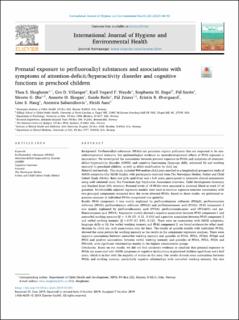| dc.contributor.author | Skogheim, Thea Steen | |
| dc.contributor.author | Villanger, Gro Dehli | |
| dc.contributor.author | Weyde, Kjell Vegard Fjeldheim | |
| dc.contributor.author | Engel, Stephanie M. | |
| dc.contributor.author | Suren, Pål | |
| dc.contributor.author | Øie, Merete Glenne | |
| dc.contributor.author | Skogan, Annette Holth | |
| dc.contributor.author | Biele, Guido | |
| dc.contributor.author | Zeiner, Pål | |
| dc.contributor.author | Øvergaard, Kristin Romvig | |
| dc.contributor.author | Haug, Line Småstuen | |
| dc.contributor.author | Sabaredzovic, Azemira | |
| dc.contributor.author | Aase, Heidi | |
| dc.coverage.spatial | Norway | en_US |
| dc.date.accessioned | 2022-05-31T13:49:14Z | |
| dc.date.available | 2022-05-31T13:49:14Z | |
| dc.date.created | 2019-10-22T20:11:04Z | |
| dc.date.issued | 2019 | |
| dc.identifier.citation | International Journal of Hygiene and Environmental Health. 2019, 223 (1), 80-92. doi: 10.1016/j.ijheh.2019.10.003. Epub 2019 Oct 22. | en_US |
| dc.identifier.issn | 1438-4639 | |
| dc.identifier.uri | https://hdl.handle.net/11250/2997086 | |
| dc.description.abstract | BACKGROUND:
Perfluoroalkyl substances (PFASs) are persistent organic pollutants that are suspected to be neurodevelopmental toxicants, but epidemiological evidence on neurodevelopmental effects of PFAS exposure is inconsistent. We investigated the associations between prenatal exposure to PFASs and symptoms of attention-deficit/hyperactivity disorder (ADHD) and cognitive functioning (language skills, estimated IQ and working memory) in preschool children, as well as effect modification by child sex.
MATERIAL AND METHODS:
This study included 944 mother-child pairs enrolled in a longitudinal prospective study of ADHD symptoms (the ADHD Study), with participants recruited from The Norwegian Mother, Father and Child Cohort Study (MoBa). Boys and girls aged three and a half years, participated in extensive clinical assessments using well-validated tools; The Preschool Age Psychiatric Assessment interview, Child Development Inventory and Stanford-Binet (5th revision). Prenatal levels of 19 PFASs were measured in maternal blood at week 17 of gestation. Multivariable adjusted regression models were used to examine exposure-outcome associations with two principal components extracted from the seven detected PFASs. Based on these results, we performed regression analyses of individual PFASs categorized into quintiles.
RESULTS:
PFAS component 1 was mainly explained by perfluoroheptane sulfonate (PFHpS), perfluorooctane sulfonate (PFOS), perfluorohexane sulfonate (PFHxS) and perfluorooctanoic acid (PFOA). PFAS component 2 was mainly explained by perfluorodecanoic acid (PFDA), perfluoroundecanoic acid (PFUnDA) and perfluorononanoic acid (PFNA). Regression models showed a negative association between PFAS component 1 and nonverbal working memory [β = -0.08 (CI: -0.12, -0.03)] and a positive association between PFAS component 2 and verbal working memory [β = 0.07 (CI: 0.01, 0.12)]. There were no associations with ADHD symptoms, language skills or IQ. For verbal working memory and PFAS component 2, we found evidence for effect modification by child sex, with associations only for boys. The results of quintile models with individual PFASs, showed the same pattern for working memory as the results in the component regression analyses. There were negative associations between nonverbal working memory and quintiles of PFOA, PFNA, PFHxS, PFHpS and PFOS and positive associations between verbal working memory and quintiles of PFOA, PFNA, PFDA and PFUnDA, with significant relationships mainly in the highest concentration groups.
CONCLUSIONS:
Based on our results, we did not find consistent evidence to conclude that prenatal exposure to PFASs are associated with ADHD symptoms or cognitive dysfunctions in preschool children aged three and a half years, which is in line with the majority of studies in this area. Our results showed some associations between PFASs and working memory, particularly negative relationships with nonverbal working memory, but also positive relationships with verbal working memory. The relationships were weak, as well as both positive and negative, which suggest no clear association - and need for replication. | en_US |
| dc.description.sponsorship | This research was funded by the Research Council of Norway (MILJØFORSK, project no. 267984/E50 “NeuroTox”), National Institutes of Health (NIH) R01ES021777, and National Institute of Environmental Health Sciences (NIEHS) P30 ES010126. The ADHD Study, from which the present data were drawn, was supported by funds and grants from the Norwegian Ministry of Health, the Norwegian Health Directorate, the South-Eastern Health Region, G&PJ Sorensen Fund for Scientific Research, and from the Norwegian Resource Centre for ADHD, Tourette syndrome and Narcolepsy. The Norwegian Mother, Father and Child Cohort Study is supported by the Norwegian Ministry of Health and Care Services and the Ministry of Education and Research, NIH, and National Institute of Neurological Disorders and Stroke (NINDS) (grant no.1 UO1 NS 047537-01 and grant no.2 UO1 NS 047537-06A1). We are grateful to all the participating families in Norway who take part in this on-going cohort study, and to the staff of the ADHD Study. | en_US |
| dc.language.iso | eng | en_US |
| dc.publisher | Elsevier | en_US |
| dc.rights | Attribution-NonCommercial-NoDerivatives 4.0 Internasjonal | * |
| dc.rights.uri | http://creativecommons.org/licenses/by-nc-nd/4.0/deed.no | * |
| dc.subject | Attention-deficit/hyperactivity disorder (ADHD); Cognitive functions; Father and Child Cohort Study (MoBa); Perfluoroalkyl substances (PFASs); Prenatal; The Norwegian Mother | en_US |
| dc.title | Prenatal exposure to perfluoroalkyl substances and associations with symptoms of attention-deficit/hyperactivity disorder and cognitive functions in preschool children | en_US |
| dc.type | Peer reviewed | en_US |
| dc.type | Journal article | en_US |
| dc.description.version | publishedVersion | en_US |
| dc.rights.holder | © 2019 Elsevier GmbH. All rights reserved. | en_US |
| dc.source.pagenumber | 80-92 | en_US |
| dc.source.volume | 223 | en_US |
| dc.source.journal | International Journal of Hygiene and Environmental Health | en_US |
| dc.source.issue | 1 | en_US |
| dc.identifier.doi | 10.1016/j.ijheh.2019.10.003 | |
| dc.identifier.cristin | 1739678 | |
| dc.relation.project | Research Council of Norway: (MILJØFORSK, project no. 267984/E50 “NeuroTox”) | en_US |
| cristin.unitcode | 1991,1,2,0 | |
| cristin.unitname | Avd Forskning | |
| cristin.ispublished | true | |
| cristin.fulltext | original | |
| cristin.qualitycode | 1 | |

